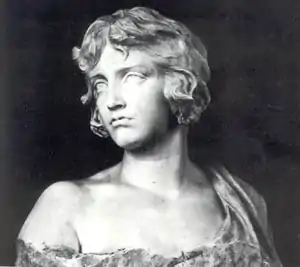Nossis
Nossis (Greek: Νοσσίς) was a Hellenistic Greek poet from Epizephyrian Locris in southern Italy.[1] She seems to have been active in the early third century BC, as she wrote an epitaph for the Hellenistic dramatist Rhinthon.[2] She primarily wrote epigrams for religious dedications and epitaphs.[3] Her epigrams were inspired by Sappho, whom she claims to rival.[4] She may have also been influenced by Erinna and Anyte.[5] Antipater of Thessalonica included her in his canon of nine female poets.[6]
Nossis | |
|---|---|
 Nossis (marble bust by Francesco Jerace) | |
| Native name | Νοσσίς |
| Born | Epizephyrian Locris |
| Died | Epizephyrian Locris |
| Resting place | Unknown |
| Occupation | Poet |
| Language | Greek |
| Citizenship | Locrian |
| Years active | c. 300 BC |
| Children | Melinno (presumed) |
Nossis is one of the best preserved Greek women poets, with twelve epigrams attributed to her preserved as part of the Greek Anthology, the majority of which are about women.[7] One of these poems (preserved as A. P. 5.170) is modelled after Sappho's fragment 16.[8] Meleager of Gadara, in his Garland, includes her among the most distinguished Greek singers.
Nossis states in her work that her mother was named Theuphila, the daughter of Cleouchas. In another epigram, she mentions that she had a daughter named Melinna,[9] who is possibly the poet Melinno.
References
- Barnard, Sylvia. "Hellenistic Women Poets". The Classical Journal, 73.3 (1978). p. 204.
- Skinner, Marylin. "Homer's Mother". In Greene, Ellen (2005). Women's Voices in Ancient Greece and Rome. n. 11.
- Bowman, Laurel. "The 'Women's Tradition' in Greek Poetry". Phoenix, 58.1 (2004). p. 16.
- Snyder, Jane McIntosh. The Women and the Lyre. (1991. Southern Illinois University Press, Carbondale). See Anthologia Graeca 7:718.
- Bowman, Laurel. "The 'Women's Tradition' in Greek Poetry". Phoenix, 58.1 (2004). p. 20.
- Fernandez Robbio, Matías S. (2014) «Musas y escritoras: el primer canon de la literatura femenina de la Grecia antigua (AP IX 26)». Praesentia, v. 15, 2014, pp. 1-9. ISSN (en línea): 1316-1857. (online)
- Barnard, Sylvia. "Hellenistic Women Poets". The Classical Journal, 73.3 (1978). p. 210.
- Barnard, Sylvia. "Hellenistic Women Poets". The Classical Journal, 73.3 (1978). p. 211.
- William Smith, Dictionary of Greek and Roman Biography and Mythology, London: Murray (1849), "Melinno"
Further reading
- Skinner, Marilyn B. "Aphrodite Garlanded: Erôs and Poetic Creativity in Sappho and Nossis". in Rabinowitz, Nancy Sorkin and Auranger, Lisa. Among Women: From the Homosocial to the Homoerotic in the Ancient World. University of Texas Press, Austin. 2002.
- Bowman, L. 1998. “Nossis, Sappho and Hellenistic Poetry.” Ramus 27.1: 39–59.
- Gigante, M. 1974. “Nosside.” PP 29: 22–39.
- Gow, A. S. F., and D. L. Page, eds. 1965. The Greek Anthology: Hellenistic Epigrams. 2 vols. Cambridge.
- Gutzwiller, K. J. 1998. Poetic Garlands: Hellenistic Epigrams in Context. Berkeley, Los Angeles and London.
- Skinner, M. B. 1989. “Sapphic Nossis.” Arethusa 22: 5–18.
- Skinner, M. B. 1991. “Nossis Thêlyglôssos: The Private Text and the Public Book.” In S. B. Pomeroy, ed., Women’s History and Ancient History. Chapel Hill and London: 20–47.
- Skinner, M. B. 2001. “Ladies’ Day at the Art Institute: Theocritus, Herodas, and the Gendered Gaze.” In A. Lardinois and L. McClure, eds., Making Silence Speak: Women's Voices in Greek Literature and Society. Princeton, N.J., 201–22.
External links
 Greek Wikisource has original text related to this article: Νοσσίς
Greek Wikisource has original text related to this article: Νοσσίς- Text of her 12 surviving epigrams